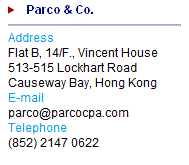 Tax
TaxPreparing Profits Tax Computation
Completing Profits Tax Return (Form BIR 51)
A taxpayer who files an “incorrect return” - by omitting or understating anything which the Inland Revenue Ordinance requires to be stated - without “reasonable excuses” commits an offence. The Commissioner of the Inland Revenue Department has the power to levy an assessment of additional tax or prosecuting the taxpayer for such offence.
We help you and your company to prepare and submit a correct return promptly.
Applying for extension
The IRD requires tax returns to be completed and enquiries answered within a specific period of time, usually from 21 days to 3 months. Late return or reply may be subject to a fine or estimated assessment.
We may apply for a further extension in the capacity of your tax representatives in some cases and advise you on how to deal with some of the IRD’s enquiries.
Objection to assessment
When you receive a notice of assessment (you can tell whether it is a “normal assessment”, “estimated assessment” or “additional assessment” by referring to the small print of the “assessor’s notes” at the back of the notice) and do not agree to the amount assessed, you must lodge an objection in accordance with the Inland Revenue Ordinance within one month after the date of the notice; Otherwise, the assessment will most likely becomes “final and conclusive”, i.e. you have to
pay the amount assessed even it turns out that you would not have been liable to tax if a proper objection has been lodged. Sounds harsh? It can be. The IRD may even issue further assessments if you do not lodge any objection at all.
We advise you to contact us or the IRD as soon as you receive an assessment and do not know what to do about it.
Holdover of provisional tax
Provisional tax is a tax which the IRD assess you or your company needs to pay in the following year of assessment. You can apply for an entire holdover, or a reduction of, the provisional tax under several circumstances, one of which is when the assessable profits for the year of assessment concerned are, or are likely to be, less than 90% of that of the preceding year of assessment.
Similar to objection, a taxpayer is required to apply for a holdover within a period of time after the date of the notice, which is 28 days before the due date for payment of the provisional tax, or 14 days after the date of issue of the notice, whichever is the later.
Replying letters and queries from the IRD in a prompt manner
Some enquiries from the IRD are straight forward which taxpayers can simply handle on their own. You should, however, be cautious to those that seems lengthy or may have considerable tax implications such as concerns over capital or revenue nature of property transactions.
We will give you advice based on our experience and published tax cases of recent years.
Assistance on Employer’s Returns (Forms IR56A, 56B, 56E, 56F etc)
The IRD will issue Forms B.I.R. 56A and I.R. 56B to employers for filing the remuneration and pensions of their employees. These forms are required to be submitted within one month or penalty will be imposed. The IRD has published comprehensive explanatory note on these two forms. You can visit the IRD’s website or click here for a copy.
Assistance on Notification of Remuneration Paid To Persons Other Than Employees
Form IR 56M
Double taxation relief
Field audit and tax investigation
Personal tax advice and compliance
Although personal tax advice could hardly be any professional firm’s core services, we do offer comprehensive review on our clients’ Individual Tax Returns, upon request, to make sure that provisions relating to personal tax allowances and exemptions, where applicable, are properly utilized.
The Inland Revenue Ordinance imposes various time limits for the above filings and applications. Hence, you should contact us as soon as you receive any tax letters, forms or assessments.
Making sense of some of the IRD’s letters and forms
Most of the IRD’s letters or forms are assigned a code on the lower left corner. What follows are brief explanation and general advice on some of the common forms which the Inland Revenue Department usually send to corporate taxpayers.
Form B.I.R. 51
This is a “Profits Tax Return” for corporations.
You should complete and submit this Return, together with a set of audited accounts, tax computation, a Form I.R. 51S, and in some cases a Memorandum and Articles, to the IRD within one month from the date of the Return.
You are advised to notify your tax representatives to apply for an extension for filing the Return, if appropriate.
Please note that the IRD may not require you to submit all of the above documents if your company is a “small corporation”.
Form 1931
This is a “Tax Demand Notice”.
You should check whether the amount assessed is the same as that reported on the Profits Tax Return.
If so, all you need to do is to pay the tax before the payment due date so as to avoid a 5% surcharge of the tax amount being levied.
If the amount assessed is different from that reported on the Profits Tax Return, read the assessor’s note at the back of the Notice. Generally, the assessor will explain the adjustment(s) he has made. E.g. expenses might have been disallowed or depreciation allowances have been reduced.
Please note that this Notice can also be an “Estimated Assessment” (“E.A.”) issued by the Inland Revenue Department in the absence of a Profits Tax Return.
If you do not agree with the assessment, you should lodge an objection within one month of the Notice. Otherwise, the assessment will most likely becomes “final and conclusive”, i.e. you have to pay the amount assessed even it turns out that your company would not have been liable to tax if a proper objection has been lodged. The IRD may even issue further assessments (Form 1932) if you do not lodge any objection at all.
Form 1812
This letter simply says that the IRD may not issue a Profits Tax Return to your company in the near future.
However, it remains your responsibility to report any assessable profits, or incidence of certain changes of status (see paragraphs (i) to (vii) on the Form), to the IRD within a specified period of time or your company may be fined.
We therefore advise you to continue your accounting record keeping and annual audit, so that we can inform the IRD of your assessable profit, if any, to avoid a possible fine.
Form 1937
This letter is called “Loss Computation”. It confirms that your company has no chargeable profits for the year of assessment concerned.
It usually shows the amounts of
1. loss brought forward from previous assessment (if any);
2. adjusted loss for the year of assessment concerned; and
3. loss carried forward to the next year of assessment.
Read the assessor’
s note at the back of the Notice, if any, for any adjustment or calculation he might have made which caused a difference from the loss (or profit) in the Profits Tax Return. If you do not agree with the computation, you should write to the IRD stating the reasons.
Form 1902
This is a “Tax Assessment Notice AND Refund of Tax”.
You should check whether the amount assessed is the same as that reported on the Profits Tax Return and see if you agree with the assessor’s note on the back of the assessment, if any.
You should lodge an objection within one month if you do not agree to the assessed amount or any particulars on the Notice.
If you agree with the assessment and the amount of tax refund, simply deposit the “tax refund cheque” attached on the bottom of the assessment to your company’s bank account.
Form 1932
This is an "Additional Assessment".
It is usually issued by the Inland Revenue Department due to non-compliance, e.g. failure to provide a return when required to do so.




